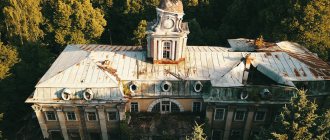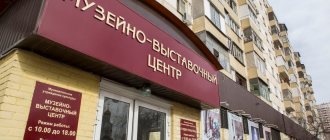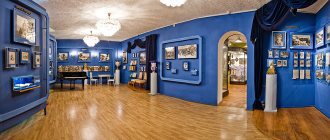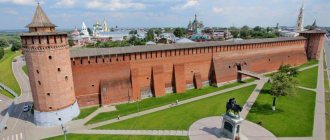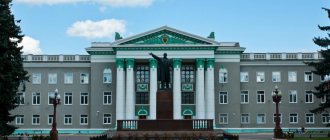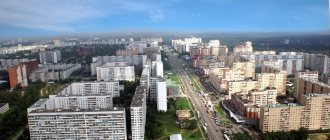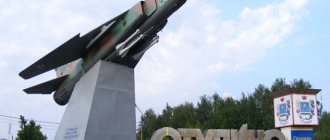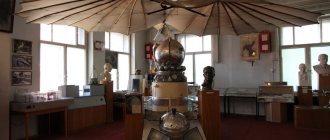The small town of Taldom near Moscow, whose population is about 13 thousand people today, is located 110 km from Moscow. Taldom is good because the town has perfectly preserved the buildings of the early 20th century; here you can see mansions in the Art Nouveau style, as well as visit the local literary museum. I managed to visit this town on an excursion, which I want to talk about in my post.
Taldom in the Moscow region
About Taldom
Small towns like Taldoma preserve that elusive spirit of the past that has long evaporated in modern cities. True, in such a city there should be a certain “guide” with you who will help you uncover all the secrets. We were lucky and found such a person. First, a few words about the name of the city. There are many versions: according to one of them, the word “Taldom” is of Finno-Ugric origin; the Finno-Ugric people had quite a few words with the root “Tal” (“Talo” - house). According to another, the word “taldom” is of Tatar origin and means “parking lot”. The latest version was voiced by Prishvin in his essay “The Shoemakers.” The first mention of Taldomu, as a village of 7 households with 38 souls, was found in 1677. The village grew and soon turned into a small county town. Residents of Taldom were engaged in the production of shoes throughout the 17th-19th centuries. They say that literally every house knew how to sew shoes. The merchant class was very strong in Taldom. These people spared no expense in improving the city; with their funds, the central square was paved with paving stones and a fire station was built. Many of the merchant mansions can still be seen today.
Taldom: history of origin, architectural and natural monuments
The administrative center of the urban district, where 13.5 thousand people now live, grew up on the site of a village in which, according to the census book, there were 7 households in 1677, but researchers have not established exactly when the settlement arose. Scientists suggest that the name, unusual for Russians, is associated with Finnish tribes who lived in the northern part of the modern Moscow region long before the 17th century.
Since the village was located in a lowland, protected from the cold northern winds, and roads converged nearby, various goods began to be brought to the river bank for sale. The small settlement became the center of the parish, and in 1860 a church was erected in Taldom. The village, whose peasants belonged to the royal court and not to the landowners, was repeatedly exposed to fires, and the number of houses, as well as inhabitants, increased slowly. At the beginning of the 17th century, when lands were actively distributed to the clergy close to the tsar, Taldom went to the possessions of the Tver archbishop.
After the decree of Catherine II, issued in 1674, which cut the church's allotments, the village became the property of the state. State-owned peasants received more rights than landowners. Villagers could trade, engage in crafts, and buy property. In the first half of the 19th century, fairs began to be organized in Taldom for religious holidays, to which peasants brought:
- clay pots;
- wooden utensils;
- flax and hemp oil;
- fresh and salted fish;
- products made of copper, silver.
Inns and taverns were opened in the village for visiting traders. With the abolition of serfdom, the number of residents of Taldom, which became the military center of the Kalyazin district, gradually began to increase, workshops, forges, and shops began to operate, and shoe crafts developed. Over time, brick boots with a layer of clay were replaced by velvet and plush boots, which were not inferior in quality to French and Italian models.
After the construction of a railway line through Taldom, buyers from all over Russia began to come to the village to buy shoes, tens of thousands of pairs of which were sewn by local artisans every year. The French women liked the elegant boots.
Despite the development of the economy in Taldom, until the end of the 19th century, neither cubes nor cinemas worked, and spiritual life was subject to the canons of the church, even schools were run by priests. The first library, the books of which became available not only to merchants, but also to ordinary residents of Taldom, opened in 1897. The merchants succeeded in laying a railway line through the village, which contributed not only to the increase in shoemaking, but led to the development of other manufacturing industries.
With the beginning of the 20th century, sawmills and brick factories, an oil mill, and a mill began operating in Taldom, and a zemstvo hospital was opened in which patients were treated for free. Stone buildings were built in the village, and the central square was paved with money allocated by merchants. Before the October Revolution, 3 dozen cooperatives operated in Taldom.
In the spring of 1918, construction of the power plant began, and in May a newspaper was published at the local printing house. In December, the village received the status of a city and the center of the county and began to be called Leninsk, which 11 years later received its previous name, which arose either in honor of the Tatar prince, or from the Finnish word for “house”. There is no consensus on the origin of the name of the settlement, which is not typical for the Russian language, among historians and scientists.
The civil war and the subsequent war communism led to a decline in shoe production, which began to recover under the new economic policy, but never returned to its previous scale. In 1929 Taldom became the center of the district. In November 1930, in honor of the deceased local revolutionary, the city was renamed Sobtsovsk, but the new name did not last long. In 1962, the Taldomsky district passed to Dmitrievsky, but 3 years later it was restored.
What you can see in Taldom:
1. In the center of the city of Taldom, the merchant buildings of the early 20th century have been preserved. 2. Historical and Literary Museum. The museum has a rather interesting exhibition dedicated to the historical past of the city and shoemaking. The second floor is dedicated to writers, natives of the Taldom region. 3. Not far from Taldom there is the Crane Homeland Nature Reserve, where in September you can see flocks of cranes. 4. In the village Spas-Ugol, E. Saltykov-Shchedrin was born in the estate.
In the Taldom Museum
Moscow Polesie – The Land of Gray Cranes
04/17/2019 Natalia Karetnikova Russia, Russia and CIS, Countries
Comments:
Taldom the administrative center of the Taldomsky district of the Moscow region. From 1918 to 1929 - Leninsk. Population: 13,819 people. (2018).
The city is located 110 km north of Moscow (90 km from the Moscow Ring Road), the Taldom-Savelovsky railway station on the Moscow - Savelovo line.
At the entrance to Taldom
Muscovites have long loved to relax in the northernmost Taldomsky district of the Moscow region. The forests here are beautiful, filled with mushrooms and berries. Fishing lovers will not be left without a good catch on the Dubna and Khotcha rivers. But not many vacationers know about what interesting places are nearby. I didn’t find out about them right away either. Quite by chance, on my next trip to Taldom, I met the employees of the Taldom regional library and the Historical and Literary Museum of the city of Taldom. Having learned that I was a journalist, they invited me to celebrate the 330th anniversary of Taldom and the village of Dubrovka - the birthplace of the poet Sergei Klychkov, a close friend of Sergei Yesenin.
N. Karetnikova at the monument to S. Klychkov in Taldom
I knew very little about Klychkov. This topic interested me. There are only two days left before the holiday, but I managed to write a poem about Taldom.
HELLO TO THE CRANE LAND
I have been acquainted with you for a long time, - Taldom is Muscovy’s native son. Cranes breed here, arriving every year in the spring.
The breeze is a rake. And recently I had a chance to see how a handsome elk suddenly appeared from the forest on the Taldomskoe highway!
Taldom, your life is leisurely: Attics, platbands in patterns. Your speech is calm, unpretentious, and can be heard in your native open spaces.
You always welcomed strangers. These meetings were heated. Yesenin was here, Konenkov, Prishvin, and Muscovites are still visiting here.
In the morning, mischievous magpies spread city gossip to everyone. Suddenly, ruddy lightning will sparkle, and warm summer rain will pour from the sky.
Here there is freedom and joy for the heart! And summer residents must admit: The grace of Dubna saves them from the bustle of the capital and the children!
So I, like a naughty girl, come to Taldom as if to heaven. Be alive, shoe side, the northernmost region of Moscow!
Famous Russian writers M.E. visited Taldom. Saltykov-Shchedrin, M.M. Prishvin, A.S. Novikov-Priboy and I.S. Sokolov-Mikitov, poet S.A. Yesenin, sculptor S.T. Konenkov, modern poets E. Yevtushenko and B. Akhmadulina, writer L.N. Vasilyeva.
Evgeny Yevtushenko among Taldom residents
Taldom is a city of Russian provincial modernism, an island of a cozy and prosperous Russian province. In the center, around the shopping area, there are merchant houses belonging to various families: the Mashatins, Klychkovs, Chernovs, Vorontsovs, Smirnovs, Kharitonovs and others.
And Taldom is the “capital” of Russian shoemakers and the richest merchants. The miraculous tower of rich merchants and manufacturers has been perfectly preserved there. They did not skimp on the lush tiled decoration of their mansions.
The coat of arms of Taldom is decorated with a silver crane in a red morocco boot, and this is not without reason! Since the 17th century, the shoe industry was developed in Taldom and its environs. Shoe making was one of the main occupations of Taldom residents in the 18th-19th centuries.
Museum exposition. In the shoemaker's workshop
At the beginning of the 20th century, Taldom artisans produced up to 10 million pairs of shoes per year. Shoe fairs were held in Taldom, attracting numerous shoe buyers. After the arrival of the railway in Taldom in 1901, the shoe trade flourished; at the beginning of the 20th century, Taldom merchants built a number of stone houses in the center of the village (one of them, which belonged to the merchant Volkov, now houses a historical and literary museum)
Once Taldom supplied half of Russia with shoes, and enterprising Taldom merchants managed to build a railway through the city. Taldom shoemakers were especially successful in the production of ladies' shaped shoes.
There is a legend that at the beginning of the 19th century, a French woman, having taken a pair of fashionable “Romanian” shoes from Taldom, sold them so profitably in Paris that she paid for her trip to Russia!
Today the main enterprises of the city are: shoe and clothing factories, technological equipment factories, asphalt concrete, metal structures, bakery.
Walking along the ancient streets of Taldom, you will admire the luxurious old Fire Tower, which is now very creatively located in the district registry office.
The unusual “tiled” Church of the Archangel Michael will delight you with its beauty of golden domes flying to the sky. Its elegant bell tower was erected in a rarely seen Russian-Byzantine style. The temple is located in the city center. It began construction in 1795, and was consecrated only in 1808. In the 1870s, a faience-enamel iconostasis was installed in the temple, fragments of which can be seen today in the Taldom Museum.
At the end of the 19th century, the temple was partially rebuilt. The project for rebuilding the temple in pseudo-Russian style can be seen in the museum. During Soviet times, the temple was closed, heavily rebuilt, and housed a shoe factory. Today the temple is being successfully restored.
The history of Taldom is rich and interesting. It was known already in 1677 as the village of Taldom with seven courtyards with 38 male souls, which belonged to the Archbishop of Tver and Kashin Simeon. The name, according to the most likely version, is Finnish (from the Finnish word “talouden” - farm house). By the beginning of the 18th century, the village of Taldom became a village. Until 1744 it was part of the Dmitrovsky camp, then it belonged to the Kashinsky district, and since 1776 - to the Kalyazinsky district. I hear in the word “Tal is home!” the sound of the bells of an Orthodox church, gathering its parishioners for a festive service.
And how delicious the bread in Taldom is! At the Taldom bakery, 12 types of bakery products are baked (sliced loaf, Donskoy, Rye, Kolosok, yeast-free Homemade bread) from environmentally friendly raw materials. Flour is purchased in the Lukhovitsky, Istra districts and in the Tver region. Amazingly tasty bread is baked according to old recipes without the use of chemical additives or preservatives. It's called ECO bread!
Taldom is a real natural pearl and an incredibly picturesque and green city, decorated with emerald parks and clear lakes.
At the Gray Crane Museum
In Taldom there is a historical and literary museum, which contains historical data about the history of the city, historical photographs, books, autographs and objects belonging to writers who were natives of the Taldom land, as well as those who lived here or simply visited:
Among them are M. E. Saltykov-Shchedrin, L. N. Zilov, S. A. Klychkov, M. M. Prishvin, S. A. Yesenin, V. N. Azhaev, P. V. Slyotov and others. The museum is located in the house of the merchant of the first guild D.I. Volkov. The house is the first stone house in Taldom and was built at the end of the 19th century in the Art Nouveau style with balconies and ceilings designed by Monier. The museum has preserved its layout, doors, stoves, stucco moldings and parquet.
The Taldom regional library occupies the house of the merchant F.K. Kiselyov:
The house, built in 1907, has intricate brickwork, ornate patterns on the windows and doors, and the roof is topped with pseudo-Russian-style kokoshniks. It is an architectural monument of local importance. In August 2001, a monument to the poet Sergei Antonovich Klychkov was inaugurated in a clearing near the building of the Taldom regional library. The author of the monument is sculptor Denis Stritovich. This was his graduation work. The young talented sculptor depicted the writer dressed in ordinary clothes and sitting on a large stone, with his thoughtful gaze directed forward. Taldom residents raised funds for the construction of a monument to their fellow countryman all over the world. The sculptor did not take a penny from the residents of the city of Taldoma for his work. Only consumables were paid for.
At the monument to S. Klychkov. In the center Denis Stritovich
Sergei Antonovich Klychkov was a native of the village of Dubrovka, Taldomsky district - an outstanding poet, prose writer and publicist.
House Museum of Sergei Klychkov in the village of Dubrovki
His poems are full of love for his homeland, for his native Taldom region.
Dear, dearer to me is the glory of the expanse of my native fields, and the spring roar of the oak groves, and the cries of the cranes. There is no more wonderful sacrament, There is no other beauty, How to sow grains with a song Above the virgin spring...
Klychkov was shot in 1937 during Stalin's repressions. His name was forgotten for many years. S.A. Klychkov was a friend of the poet S.A. Yesenin and the sculptor S.T. Konenkov. He was closely acquainted with Osip Mandelstam and Anna Akhmatova. Yesenin dedicated one of his best poems to Klychkov: “I don’t regret, I don’t call, I don’t cry.”
Sergei Yesenin and Sergei Klychkov
Sergei Klychkov's lyrics are closely related to folk art. The most popular works: “The carpet fields are turning golden”, “The dawn lies like a girdle”, “The star is blazing outside the window...”, “Sadko”, “Like a friend, a cricket behind the stove...”. Sergei Klychkov wrote three novels: “The Sugar German”, “Chertukhinsky Balakir” and “Prince of Peace”. Based on the novel “The Sugar German,” the feature film “Dvinsk Tea” was shot. Current literary scholars call Klychkov the founder of the literary movement of mystical realism and the forerunner of Nobel laureate Gabriel Garcia Marquez.
Sergey Klychkov
We all know the song: “My joy lives in a high chamber.”
My joy lives in a high mansion, And in that lofty mansion no one can enter.
The history of its creation is interesting. Sergei Klychkov made a literary adaptation of the poem by the little-known poet Sergei Ryskin “Udalets”. The music was written by a gypsy guitarist and composer of the late 19th - early 20th centuries. Mikhail Shishkin. He was the accompanist of the famous singer Varya Panina. The song is still sung in this form at all feasts today. The song was liked by many famous singers. It was performed by Varya Panina, Lydia Ruslanova, Klavdiya Shulzhenko, Vadim Kozin, Olga Voronets, Boris Shtokolov, Lev Leshchenko, Sergei Zakharov.
What is surprising is that the forgotten name of Sergei Klychkov was returned to Russia by the Frenchman Michel Nico, a Slavist, professor at the University of Cannes:
Michelle Nico and Natalia Karetnikova
After a long period of oblivion, S. Klychkov’s poems and novels were published in France, and then in Russia. It is gratifying that in the 21st century the books of S.A. Klychkov is read, composers write songs based on his poems. International festivals named after him are held in Moscow, with the title “My Soul is Like a Bird,” taken from his poem.
Laureates and diploma recipients of the Silver Crane festival
As the organizer of this festival, I can say one thing: “The work of Sergei Klychkov is still in demand today!” His works are studied at philological faculties of universities in Russia and abroad.
Festival, dance of the gray crane
The cultural life of Taldom is rich and varied. The festival of art songs and poetry “Silver Crane” is held there (once every 2 years); Moscow regional festival competition of folklore ensembles “Dubravna” (once every 2 years)
Regional literary festival dedicated to the work of S.A. Klychkov “Haymaking in Dubrovki” (annually, in July in the village of Dubrovki, on the Klychkov estate).
On City Day, the Clear Sky air show is held at the Zhuravli airfield near Taldom.
Crane Homeland - this poetic name was used to christen the beautiful swampy lowland, not far from the city of Taldoma, by the great Russian writer and naturalist M.M. Prishvin.
He was in love with these hidden swampy lakes in the deep forests, over which in the fall, beautiful cranes fly, crying sadly, gathering in flocks for a long-distance flight to winter in warm regions.
After walking around the city and working up an appetite, you can have lunch at the Zhemchuzhina restaurant-chalet on the shore of the lake:
It’s not for nothing that it’s called that: in the old days it was said that stingray pearls were mined in the rivers and lakes of the Moscow region.
I invite you to Taldom! Here you can immerse yourself in the special atmosphere of the cozy and leisurely life of a small town and enjoy the beauty of the wonderful surroundings, and learn a lot of interesting things from the history of this northernmost original Russian town of Moscow Polesie.
It is no coincidence that my best poems were born in the Taldom region and were included in the lyrical cycle “Taldom Motives”.
IN MY PALISADE
In my palisade there are elderberries and currants. And the crane cries over the silent stubble. He sings about you, homeland of the cranes - Dear Taldom region, where we have lived for a long time.
Behind my fence there are unprecedented flowers: Poems are blooming in my palisade! And the brook gurgles, and the scarlet dawn looks upon the quiet highway and my old house.
Come, friends! There is a reason for us to meet. Golden balls promise good luck to everyone. Clusters of thin rowan trees hang down to the windowsill, On the porch there is a basket of autumn honey mushrooms.
Let my happiness not end in the palisade! We will gather again at the set table. The dome of clear skies stretches far, Like the future life in my palisade!
I am sure that for many Taldom will become a kind of discovery city. It is so bright and colorful, well-groomed, surrounded by greenery of parks, decorated with transparent crystal lakes.
How to get to Taldom from Moscow
By car along Dmitrovskoye Highway to the city of Dmitrov, then turn to Taldom.
There are electric trains from Savyolovsky station to Taldom (direction – to Savelovo, make a stop in Taldom) and a long-distance bus. Travel time is approximately 1.5 hours or a little longer. (By car, due to traffic jams leaving Moscow, it will take longer.)
Taldom Museums - addresses and opening hours
Taldom Historical and Literary Museum in Taldom Address: Moscow region, Taldom, st. Saltykova-Shchedrina, 41 Opening hours: Tue. – Fri. 09:00-18:00 hour; Sat, Sun 09:00-17:00 hours. Monday is a day off. Telephone
House-Museum of S.A. Klychkova Address: Russia, Moscow region, Taldom, Dubrovki village, 24-A Tel. Opening hours: Tue. – Sat. 10:00 – 16:00 hours. Sunday and Monday are days off.
If you liked this note or helped, share it with your friends and on social networks, the “Share” buttons are below.
Related notes:
Dmitrov yesterday and today Legends and traditions of the Dmitrov region Yakhroma. Neighborhoods of Yakhroma and Dmitrov Moscow Polesie - Land of Gray Cranes All notes by the same author
Useful links:
Buy bus tickets to Taldom Buy train tickets across Russia Book a hotel or apartment in Taldom Apply for a travel insurance policy online
share link:
Add a comment Cancel reply
- Sergey Lyubushin
17.04.201910:19
What great fellows the Russian merchants were! The money was invested in the beauty of their hometown, and not taken abroad... I had never heard of the poet Klychkov before. And now I will know! Thanks to the author of the article. And your poems are wonderful.
Answer
- Karetnikova Natalia
17.04.201920:01
Author: Sergey Lyubushin
What great fellows the Russian merchants were! The money was invested in the beauty of their hometown, and not taken abroad... I had never heard of the poet Klychkov before. And now I will know! Thanks to the author of the article. And your poems are wonderful. Thank you to everyone who read my article about Taldom!
Answer
- Karetnikova Natalia
17.04.201922:41
Author: Sergey Lyubushin
What great fellows the Russian merchants were! The money was invested in the beauty of their hometown, and not taken abroad... I had never heard of the poet Klychkov before. And now I will know! Thanks to the author of the article. And your poems are wonderful. Thank you, Sergey! Of course, little is known about Klychkov, but recently many publications have appeared about him, television programs on the Culture channel were interesting. Documentary films have been made. He continues to live in his poetry and prose.
Answer
- Irina Fedorchenko
17.04.201911:32
I met the Author ten years ago on the Internet. Natasha is a wonderful, kind, cheerful friend who knows how to see beauty and share her wondrous, gentle, touching poems with friends and readers. I have several collections of her poems, donated by the author. It’s a pity that personal meetings are not as frequent as we would like, but I know that Natasha is now working on her first book of prose. And the story that was published today touched me with its love for Russia, for the history of my native land. Good luck to you, dear friend.
Answer
- Karetnikova Natalia
17.04.201922:35
Author: Irina Fedorchenko
I met the Author ten years ago on the Internet. Natasha is a wonderful, kind, cheerful friend who knows how to see beauty and share her wondrous, gentle, touching poems with friends and readers. I have several collections of her poems, donated by the author. It’s a pity that personal meetings are not as frequent as we would like, but I know that Natasha is now working on her first book of prose. And the story that was published today touched me with its love for Russia, for the history of my native land. Good luck to you, dear friend. Thank you, dear Irochka, for your kind words addressed to me!
Answer
18.04.201910:09
I was passing through those places, but to appreciate the beauty of the city, you probably need to live there. A very interesting and informative article. But I remember the flooded bell tower in Kalyazin. It is the last reminder of the St. Nicholas Cathedral and the Zhabensky Monastery, which went under water. Thanks for your story.
Answer
- Karetnikova Natalia
19.04.201906:22
Author: Galina Bliznyuk
I was passing through those places, but to appreciate the beauty of the city, you probably need to live there. A very interesting and informative article. But I remember the flooded bell tower in Kalyazin. It is the last reminder of the St. Nicholas Cathedral and the Zhabensky Monastery, which went under water. Thanks for your story. Thank you, Galina! We have many interesting places in Russia. And Taldom is one of them. I would like to believe that you will visit there again and not just passing through, but purposefully, to get to know this nice, cozy town.
Answer
19.04.201900:05
Thanks, very interesting. Reading about Yesenin, I remember Klychkov’s last name, but did not know about his tragic death. How many more wonderful Russian towns and places do we have that created and glorified Russia?
Answer
19.04.201917:57
Natasha, I was very glad to read your notes about the ancient Central Russian city - Taldom! Well done for introducing him to everyone reading articles on this site. Still, how wonderful these small and not always well-known towns are! I read about Klychkov, most likely in connection with Yesenin. But I didn’t hear that he wrote not only poetry, but also prose. I hope that we will still read your prose, decorated with soft and lyrical poems!
Answer
Tags:
- Interesting places in the Moscow region
- Merchant houses of Russia
- Moscow
- Moscow region
- Russian outback
- Russia | Traveling around Russia
- Sergey Klychkov
- Taldom
Shoe industry in Taldom
In the 18th-19th centuries, the shoe industry flourished in Taldom. Various shoes were made here, as can be learned from the exhibition of the historical and literary museum. In 1907, according to the statement, 35 thousand pairs of shoes were sold.
Taldom shoes were also highly valued abroad. There is even a story that only one pair of shoes could be taken out of the Russian Empire. Foreign women at the border took off their shoes, left them here, put on Taldom ones, and picked up another pair. and thus crossed the border.
Shoe industry in Taldom
Taldom
According to most scientists, the city of Taldom received its name from the Finno-Ugric tribe Merya, who inhabited these lands many years ago. In modern Finnish there is a word talo (“talo”, that is, “house”). The history of the city began at the end of the 17th century. In historical documents of those years, Taldom is mentioned as a small settlement in which no more than forty male souls lived. The number of women living in the village is not indicated anywhere. Since men were subject to the poll tax, only them were counted. The first mention of Taldom dates back to 1677. How the settlement arose is unknown to modern scientists. The exact date of its origin is also unknown. Development of shoemaking
From the first mentions of Taldom it is known that the settlement belonged to the Archbishop of Tver and Kashira Semyon. The main occupation of the local population was shoe making, which flourished in the village until the 19th century. Shoemaking provided a stable income for a considerable number of Taldom residents. Perhaps this is why at the beginning of the 20th century Taldom and the surrounding settlements were called the “center of the shoe-making district.” According to statistics of those years, every fifteenth Russian wore shoes made in Taldom or the surrounding area. Local shoemakers produced at least 15 million pairs of shoes annually.
The abundance of shoemakers in the city is explained by numerous legends. According to one of them, Tsar Mikhail Fedorovich ordered the resettlement of Kimry shoemakers. There were too many of them in Kimry, which increased competition. Considering that Taldom is located not far from Kimry, there is reason to believe that this legend may be the true story of the founding of the city. The village gradually turned into a city thanks to the production of shoes. The most successful shoemakers grew rich and became wealthy merchants. They built brick houses, imitating their Moscow colleagues. Some buildings have survived to this day. One of the most famous is the house of the merchant Volkov. Today this building houses the Historical and Literary Museum.
Taldom in the 18th – early 20th centuries.
Taldom repeatedly changed administrative subordination. Initially, the village belonged to the Kimry volost of the Kashinsky district. Then the settlement moved to the Belgorod camp of the same district. At the beginning of the 18th century, Kashinsky district was transferred to the subordination of the Uglich province. Initially Taldom was a village. It became a village only at the beginning of the 18th century (no later than 1717). In 1764, the lands were secularized. The village came under the jurisdiction of the College of Economy. Taldom becomes the center of the Taldom economic volost. Village residents began to be called economic peasants. Instead of quitrents and corvée, they had to pay a poll tax of 1.5 rubles. The money entered the state treasury through the College of Economy. It is believed that it was Taldom’s transition to the category of economic settlements that contributed to the further prosperity of the village and the establishment of the shoe industry. One of the streets of modern Taldom is named Kustarnaya in memory of the fact that handicrafts flourished in the village of Taldom. The word “handicraft” comes from the word “bush,” since a whole family was engaged in one trade.
In the “List of Populated Places of the Tver Province” for 1859, Taldom is listed as a government village in the Kalyazin district near wells, 66 versts from the district town of Kalyazin. The village had 172 households and 1,134 residents of both sexes - 548 males and 586 females. An Orthodox church and a fair are indicated.
At the end of the 19th century, a new type of transport appeared in the Russian Empire - the railway. The construction of railway lines began throughout the country. According to the plan, one of these branches was supposed to pass near the village of Taldom. However, local merchants realized the importance of the new mode of transport for profitable trade. By joint efforts, the merchants ensured that the railway ran directly through Taldom, and not to the side of it, as previously planned. A railway line appeared in the village in 1901. It is known that already in 1907 at least 35 thousand pairs of shoes were sent from Taldom station.
The advent of the railroad contributed to the development of other types of production. Furrier, fulling and tailoring trades actively developed. The presence of the forest allowed local residents to engage in logging. At the beginning of the twentieth century, there were about 180 shoemakers in the village and surrounding area. A block factory, 4 brick and 2 sawmills, a steam mill, an oil production plant and 5 wholesale shoe warehouses appeared in the city. A free public library was also built in Taldom, and a postal and telegraph office was opened. The local hospital was well equipped. Medical staff had the opportunity to live in service apartments provided by the hospital. In 1916, cinema appeared in Taldom, created on a cooperative basis. In the 1910s, the cooperative movement was popular among residents of the village and surrounding area. By 1917, about thirty cooperatives operated here.
Change of names
Revolutionary sentiments began to penetrate Taldom in 1900. The first organization of the RSDLP in the city arose on the initiative of the local shoemaker Ivan Orlov. After the revolution, Taldom was renamed and became Leninsky. It should be noted that Taldom became the first settlement in the Moscow region to be renamed in honor of the leader of the world proletariat. The renaming took place on the first anniversary of the October Revolution. Workers celebrated the anniversary with a rally, after which a congratulatory telegram was sent to Moscow to the “leaders of the revolution.” At the same time, the idea arose to rename the village Taldom to Leninsk. In addition to the new name, the village also changed its status, becoming a city. In 1921, a new Leninsky district was formed, which was subordinate to the Moscow province. But already in 1929 Taldom was returned to its historical name.
The return of the historical name was not due to the decline in the popularity of V.I. Lenin, but to the fact that several more settlements with the same or similar name appeared on the territory of the USSR. In the Moscow province alone there were 2 Lenin districts (the second was where Lenin Gorki is located). In 1930, the city experienced another renaming. Residents of Taldom insisted that the city be named after the food commissar N. Sobtsov. The commissioner was killed in 1918 during a kulak revolt. As a result, the city was renamed Sobtsovsk. The new name did not catch on and lasted even less than Leninsk. Just 2 months after the renaming, the city was again officially called Taldom. The next administrative-territorial transformations took place in 1962. The Taldomsky district was significantly reduced and merged with the Dmitrovsky district. However, after 3 years the area was restored and became independent.
Cultural life of the city
The rich history of Taldom is carefully preserved in local museums, which are opened not only on the initiative of the state. The city has many museums created by enthusiasts and patriots of their native land. Thus, Orthodox, private and school museums, as well as museums at local enterprises, appeared in Taldom. There are more than twenty museums in the Taldomsky district. There are 6 of them in Taldom itself. Local residents joke that their area can be included in the Guinness Book of Records for the number of museums per capita.
The first museum appeared in the 20s of the twentieth century and was called the “Museum of Nature and Life of the Local Region.” Its opening was timed to coincide with the May Day celebrations. The first museum was open to visitors only on Sundays. It was he who was created in the former mansion of the Taldom merchant Volkov. One of the most famous Orthodox museums is opened at the Church of the Archangel Michael. The exhibition tells about the spiritual life of the ancestors of today's Taldom residents, companions of the Orthodox faith and patron saints of the Taldom region. 2 museums were opened in the Yubileiny microdistrict. The initiators of the creation of these museums were school students and teachers. One of the museums is dedicated to the military glory of the Fakel headquarters and is located at the social rehabilitation center. The second cultural institution is dedicated to the history of Taldom. It is located at secondary school No. 3. Taldom residents can be proud that the works of the museum workers of their hometown have even been in space. In 2000, Hero of Russia Yuri Baturin took with him on a flight a booklet called “Museum of the Local Region.” This booklet was released for the eightieth anniversary of the Taldom Historical and Literary Museum.
The cultural life of Taldom is represented not only by museums, but also by theatrical life. Taldom residents have always loved theatrical performances and made repeated attempts to create, if not a theater, then at least a small theater studio or circle in their hometown. Theatrical activities are closely intertwined with the work of museum staff. In the 20s of the last century, the Taldom drama circle, together with educational circles opened at museums, repeatedly staged M. Gorky’s play “At the Depths”. In the 80s, a youth theater studio was opened at the district hospital. Amateur actors delighted the public with performances of their own fairy tales, which usually became part of New Year's performances. Az-Art (a small theater studio at the school) is considered to be the longest-living theater in Taldom.
Modern Taldom
Taldom is continuously expanding and improving due to the constant growth of the population. The city is considered one of the most environmentally friendly places in the Moscow region. The enterprises located here do not pose a threat to human health. The city's industry is represented by clothing and footwear enterprises. The city has a bakery and asphalt concrete plant, as well as a technological equipment plant. All these enterprises provide stable income to the local population without harming the city’s ecology.
Taldom is a city in the Moscow region, the center of the Taldomsky district. The city has over 14 thousand inhabitants. The city has been known as a large village since the 17th century. In 1925, Taldom was given the status of a city (from 1918 to 1929 it was called Leninsky). Later, the villages of Kostino and Vysochki also became part of Taldom.
In the last century, the territory of the modern Taldomsky district was part of the Dmitrovsky district of the Moscow province and the Kalyazi district of the Tver province. Taldom has always been famous for the products of its craftsmen - furriers and shoemakers. At the beginning of the 20th century, there was a large shoe making artel in Taldom. Up to 10 million pairs of shoes were sewn per year. Today the artel has been transformed into the Taldom shoe factory of the Moscow Production Association "Vostok". The former furrier and tailor's artels were transformed into a sewing and fur factory - a branch of the Dmitrov sewing association "Yunost". There is also a plant for technological equipment for consumer services in Taldom.
Taldom is both an ancient and modern city. In the center, shopping arcades have been partially preserved, as well as a church and several old mansions. Another small church is located at the city cemetery on the outskirts of the city. The center is located away from the main roads passing through the city, and therefore it is not too noisy. The buildings along the main roads are predominantly wooden. One of the streets, in memory of traditional crafts, is named Handicraft. Modern multi-storey buildings are typical for the north-eastern and eastern parts of the city. In the northeast of Taldom there is a modern, comfortable microdistrict “Yubileiny”. The main attractions of the city are the church and shopping arcades in the center, the monument to M.E. Saltykov-Shchedrin at the station, as well as a monument to the heroes of the Second World War on the street. Victory. There is a museum of M.E. in Taldom. Saltykova-Shchedrin on the street of the same name.
There are many ancient villages in the vicinity of the city. One of them is Spas-Ugol, the birthplace of the great Russian satirist M.E. Saltykov-Shchedrin. Spas-Ugol is located on the old Kalyazinskaya road. Four provinces converged here - Moscow, Tver, Vladimir and Yaroslavl - hence the name of the village. The Saltykovs also belonged to the villages of Novo-Okatovo, Kalyazinsky and Zaozerye, Uglich districts. In the village of Spas-Ugol, as well as in Taldom itself, there is a museum of M.E. Saltykov-Shchedrin (it will occupy part of the premises of the existing temple), and a monument to the writer was erected.
Not only the name of M.E. is associated with the Taldom land. Saltykov-Shchedrin, but also the names of other famous people. Near the city, in the village of Dubrovka, the poet and prose writer S.A. was born and lived. Klychkov. Sergei Yesenin often visited him. Another famous writer, M.M., also lived in Taldom. Prishvin. One of the city streets is named after him. Another street bears the name of Zinaida Golitsyna, a Soviet intelligence officer who was brutally tortured by the SS.
Four highways connect Taldom with neighboring towns. Through the P-112 highway you can get to Verbilki, Dmitrov, Moscow, Sergiev Posad (Zhestylevo part). In the other direction, this road leads to the village of Tempy, through which you can get to Dubna. You can get to the village of Zaprudnya through Tempy, or through Verbilki, or along the old Dmitrovskaya “grader” type road through the villages of Rastovtsy and Votrya. On the road through the village of Severny, where a large radio transmission center is located, you can get to Sergiev Posad, and also through the ancient village of Nagorye to Peraslavl-Zalessky. The last major road leads to Kimry and White Town. Along it, through the village of Kvashonki, you can get to Kalyazin, Kashin, and Uglich. Another local road leads to the village of Vorgash.
Suburban buses run along all highways - to Dubna, Zaprudnya, Vorgash, Maklakovo, Glebovo, Spas-Ugol, Severny, Verbilki, Nushpoly, Pavlovichi, Ozerskoye and other points in the region. Some routes go beyond the boundaries of the district and region - these are the bus lines Taldom - Kimry and Taldom - Nerl. Intercity bus service is carried out on the routes Kimry - Moscow (parts Taldom, Dmitrov) and Taldom - Moscow (parts Verbilki, Dmitrov and part Tempy, Dmitrov). Some buses on this line go through Zaprudnya. There are no direct flights to Bely Gorodok and Kalyazin. The Moscow-Kalyazin bus passes through Taldom and has an on-demand stop.
The railway connection through the Taldom-Savelovsky station was opened in 1900, when the construction of the Moscow-Savelovo radius of the Moscow-Yaroslavl-Arkhangelsk Railway was completed. Nowadays, railway communication is carried out by electric trains (electrification of the Verbilki-Savelovo section was completed in 1978) with Savelovo (Kimry), Dmitrov, and Moscow. Suburban communication with Dubna is carried out with a transfer at the Verbilki station, with Aleksandrov - at the Dmitrov and Yakhroma stations, and with Kalyazin, Kashin, Uglich - with a transfer at Savelovo. Long-distance communication with Rybinsk, Vesyegonsk and Pestovo is also carried out with a transfer at the Savelovo station. The Moscow - St. Petersburg service along the Savelovsky radius has been stopped!
When compiling this page, information was partially used from the brochure “In the Northern Moscow Region” (compiled by V. Savateev)

